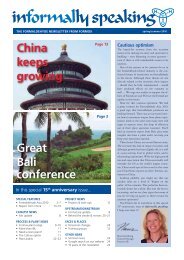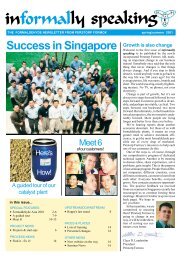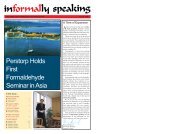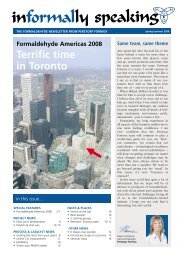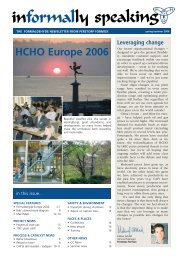Formaldehyde Europe 2012 - Perstorp Formox
Formaldehyde Europe 2012 - Perstorp Formox
Formaldehyde Europe 2012 - Perstorp Formox
Create successful ePaper yourself
Turn your PDF publications into a flip-book with our unique Google optimized e-Paper software.
Example of a MAN Turbocharger. At the front, with housing dismantled, the turbine wheel with the adjustable<br />
inlet guide vanes (VTA).<br />
tion. The standard for automotive diesel engines<br />
has changed. So perhaps we’re looking at<br />
the new standard for formaldehyde plants of<br />
the future, including a turbocharger for increasing<br />
output and saving energy.”<br />
Thanks to the pilot project carried out at<br />
EGGER’s Radauti plant, <strong>Formox</strong> and MAN<br />
have gained valuable knowledge concerning the<br />
necessary conditions for optimal operation of<br />
the turbocharger in a formaldehyde plant. As<br />
a result of the lessons learned, <strong>Formox</strong> is now<br />
able to offer the turbocharger for energy-saving<br />
at new plant installations.<br />
nearly 3 million fewer kWh = fast payback<br />
Asked about how the potential savings for a new<br />
plant, Andreas Magnusson explains that an FS3<br />
size plant operating at normal capacity can be<br />
expected to cut energy consumption by as much<br />
as 2.8 million kWh per year.<br />
“The exact savings to the customer will of course<br />
vary depending on a number of things, especially<br />
the cost of power at the site,” he says,<br />
“but there’s no question that the initial investment<br />
pays off within a relatively short time.”<br />
Part of a bigger picture<br />
Martin Steinhagen at EGGER believes that in<br />
addition to a good ROI, there are also other significant<br />
benefits to consider. “And it’s also about<br />
environmental savings, he says. At EGGER we<br />
have planned several steps to significantly reduce<br />
our good CO2 footprint until 2020, and the<br />
turbocharger is one of many other innovations,<br />
that help us to meet those goals.”<br />
Asked about how it compares to operating a<br />
conventional plant, Martin says, “No more difficult<br />
than our other plants. With the first<br />
change of the catalyst, we will inspect the unit<br />
together with MAN, but we don’t expect any<br />
problems. The turbocharger really makes sense,<br />
especially if you want to run your plant at maximum<br />
capacity.”<br />
To find out more about possibly turbocharging<br />
your plant, contact Andreas Magnusson at<br />
andreas.magnusson@perstorp.com. You can<br />
also visit www.mandieselturbo.com if you want<br />
to know more about MAn Diesel & Turbo.<br />
Figure 1. Replacing the pressurization blower with an energy-saving turbocharger.<br />
Special feature |<br />
Pressurization ‘for free’<br />
– how the turbocharger works<br />
Traditionally, oxide plants only recover the<br />
thermal energy – by means of the ecS<br />
steam generator. The turbocharger now<br />
advances energy efficiency even further.<br />
How?<br />
Assume your plant is running at 0.5 bar<br />
g absorber top pressure with 10 vol%<br />
inlet. energy consumption is then approximately<br />
57 kWh/MT when the catalyst<br />
is fresh, and 65 kWh/ MT 37% after<br />
half the catalyst lifetime. Under these<br />
conditions the turbocharger will reduce<br />
the power usage by 19 kWh to 46 kWh/<br />
MT 37% at mid cycle – about 30% less.<br />
How the turbocharger is powered<br />
The turbocharger is driven using the<br />
pressure of the gas leaving the absorber<br />
plus the heat generated through the catalytic<br />
combustion in the ecS (emission<br />
control System). Together these drive the<br />
turbine unit, which in turn directly drives<br />
the compressor. In addition, the Variable<br />
Turbine Area (VTA) feature enables efficient<br />
control of the compressor pressure<br />
output according to the plant’s needs.<br />
“As a result,” says Andreas Magnusson,<br />
“the cost of powering the turbocharger<br />
is limited to a 30-40 °c drop in the temp<br />
er ature of the gas leaving the ecS<br />
reactor. This translates into a 3-4% reduction<br />
in steam production, meaning<br />
pressurization is achieved more or less<br />
for free.”<br />
11




